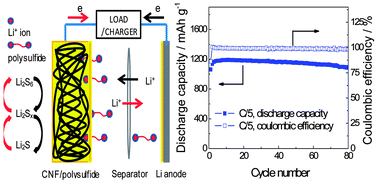Conventional lithium–sulfur batteries suffer from rapid capacity fade which limits their commercialization applications. Li/dissolved polysulfide cells with binder-free, interwoven, self-standing carbon electrodes show outstanding performance in terms of capacity utilization and reversibility. To further understand this system, we present here a binder-free carbon nanofiber (CNF) paper electrode with large interspaces between fibers, low manufacturing cost, and high polysulfide loadings. The 3D interwoven structure of the CNF paper electrode allows transitions between high-order polysulfides (charged products) and lithium sulfide (discharged product) to occur within a confined environment. Crystalline Li2S is found within the large interspaces of the 3D electrode framework after the 1st discharge, avoiding the formation of dense passivation layers on the cathode. The robust porous CNF paper electrode leads to superior electrochemical performance with a reversible capacity of 1094 mA h g−1 after 80 cycles at a C/5 rate and Coulombic efficiencies above 98% with a sulfur loading of 1.7 mg cm−2. A stable reversible capacity of ∼900 mA h g−1 is obtained with a much higher sulfur loading of 5.1 mg cm−2, making this battery configuration promising for practical applications.

You have access to this article
 Please wait while we load your content...
Something went wrong. Try again?
Please wait while we load your content...
Something went wrong. Try again?


 Please wait while we load your content...
Please wait while we load your content...